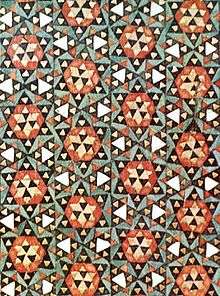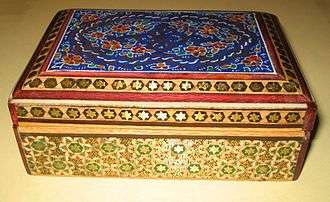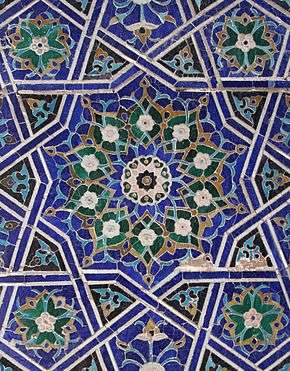Khatam

Khātam (Persian: خاتم) is an ancient Persian technique of inlaying. It is a version of marquetry where art forms are made by decorating the surface of wooden articles with delicate pieces of wood, bone and metal precisely-cut intricate geometric patterns. Khatam-kari (Persian: خاتمکاری) or khatam-bandi (Persian: خاتمبندی) refers to the art of crafting a khatam. Common materials used in the construction of inlaid articles are gold, silver, brass, aluminum and twisted wire.
Design and construction
Designing of inlaid articles is a highly elaborate process. There are sometimes more than 400 pieces per square inch in a work of average quality.[1] In each cubic centimeter of inlaid work, up to approximately 250 pieces of metal, bone, ivory and different kinds of wood are laid side by side, glued together in stages, smoothed, oiled and polished. Inlaid articles in the Safavid era took on a special significance as artists created their precious artworks. Woods used include betel, walnut, cypress and pine. These works include doors and windows, mirror frames, Quran boxes, inlaid boxes, pen and penholders, lanterns and shrines.[2][3]
Examples

The ornamentation of the doors of holy places predominantly consists of inlaid motifs. Samples of these can be observed in the cities of Mashhad, Qom, Shiraz and Rey. In the Safavid era, the art of marquetry flourished in the southern cities of Iran, especially in Isfahan, Shiraz and Kerman. The inlaid-ornamented rooms at the Saadabad Palace and the Marble Palace in Tehran are among masterpieces of this art.
Current status
Khatam is practiced in Isfahan, Shiraz and Tehran. The art of inlaid and sudorific woodwork is undertaken in the workshops of the Cultural Heritage Organization of Iran, as well as in private workshops.
Master Mohammad Bagher Hakim-Elahi (محمد باقرحكيم الهي) was a master of this art, and learned the techniques from Master Sanee Khatam in Shiraz. Later in life, in early 1950's, he moved to Tehran, where he lived until the end of his life in March 2012. He continued making Khatam master pieces, ranging from small frames, and jewelry boxes, to large items such as coffee tables, bed frames, dinner tables, and large chandeliers, some of which are currently in Museums in Iran, but most are in private collection all around the world, including southern California. He also taught the art to his younger brother Asadolah Hakim-Elahi (ﺍﺴﺪﷲ ﺤﻛﻴﻢﺍﻠﻬﻰ). Asadolah died from lymphoma in the late 1970s when he was in his mid 40s.
References
- ↑ Smith, C. S. (1967). Materials. Scientific American, 69.
- ↑ Burke, Andrew (15 September 2010). Iran. Lonely Planet. p. 70. ISBN 978-1-74220-349-2.
- ↑ Shojanoori, Nikoo (2014). "A Background of Khatam Art". European Online Journal of Natural and Social Sciences. 3 (4. Special I ssue on Architecture, Urbanism, and Civil Engineering).
